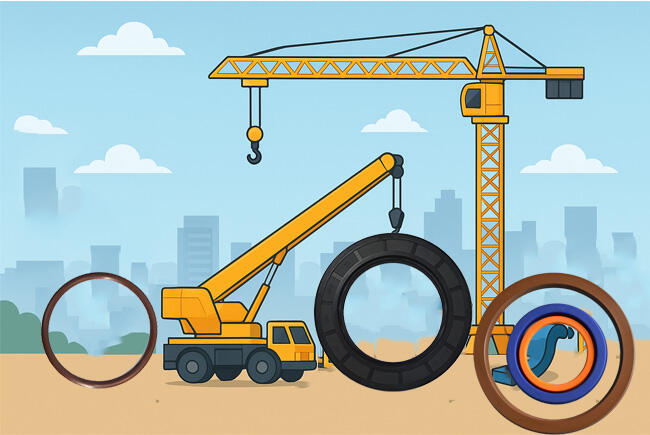Having worked in the sealing industry for over 30 years, I've frequently been involved in the maintenance and assembly of various large-scale machinery, with cranes being a particularly prominent application. Cranes are more reliant on seals than many people realize. Whether it's the hydraulic system, transmission system, or various slewing and hoisting mechanisms, a seal failure can result in downtime and losses far exceeding the cost of a single seal. Therefore, understanding the common seal types used on cranes is crucial for dealers, maintenance providers, and even end users.
1. Common Seal Types
Rod and Piston Seals: These work in pairs inside hydraulic cylinders. The rod seal keeps oil in, the piston seal divides pressure chambers. On mobile cranes exposed to dust, I prefer PU-based rod seals with an added wiper — they last longer between services.
Rotary Shaft Seals: In slewing rings and winch gearboxes, they keep grease in and contaminants out. We once upgraded a client from standard NBR to FKM/PTFE hybrids; leakage dropped by half during monsoon season.
O-Rings: in Static Joints Simple, cheap, but sensitive to groove finish and compression set. On lattice boom cranes, they often seal between gearbox covers and bearing housings.
Glyd Rings and Wear Rings: For long-stroke cylinders, especially on telescopic booms. They combine low-friction sliding with high-pressure resilience, avoiding stick-slip during precision lifts.
Material Choices Matter:In port cranes, salt spray eats away at standard rubbers; FKM or specially compounded NBR holds up better. In steel mill ladle cranes, heat is the enemy — PTFE blends excel here. Matching material to environment is half the battle.

A Note for Distributors and OEM
If you’re supplying seals to crane maintenance teams, speed of delivery can win or lose contracts. That’s why we keep critical profiles in stock year-round. And when you need a non-standard seal, our in-house manufacturing means you don’t wait for a distant factory queue.
Real-World Q&A
Q: Can you replace seals from an obsolete imported model?
A: Yes — send us dimensions or samples. We reverse-engineer, test, and supply, often improving material in the process.
Q: Do you provide documentation for export markets?
A: We issue bilingual inspection and performance reports, streamlining customs clearance and client acceptance.
Crane Seals for cranes aren’t glamorous, but they are decisive. A minor leak can ground a 200‑ton lift, disrupt schedules, and cost thousands. Partnering with a supplier who understands both the technical side and the urgency — that’s where NQKSF proves its worth, job after job.
With over 30 years in sealing systems, NQKSF covers both ends of the spectrum:
Immediate Availability — Thousands of standard sizes for O-rings, oil seals, and more, ready to ship worldwide.
Custom Engineering — From selecting the right polymer to optimizing lip geometry, we design for your exact load, speed, and temperature.
Proven Reliability — Our seals operate in cranes across over 80 countries, in climates from arctic docks to desert construction sites.
 Hot News
Hot News